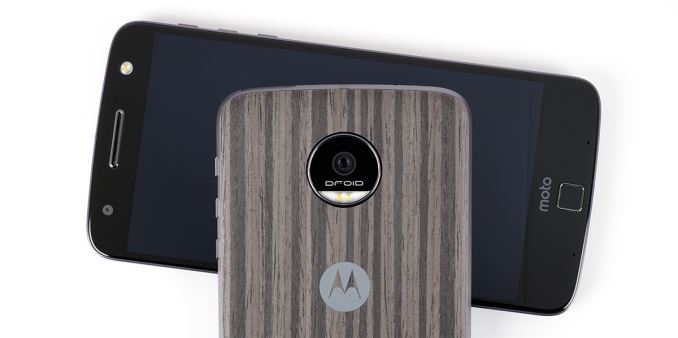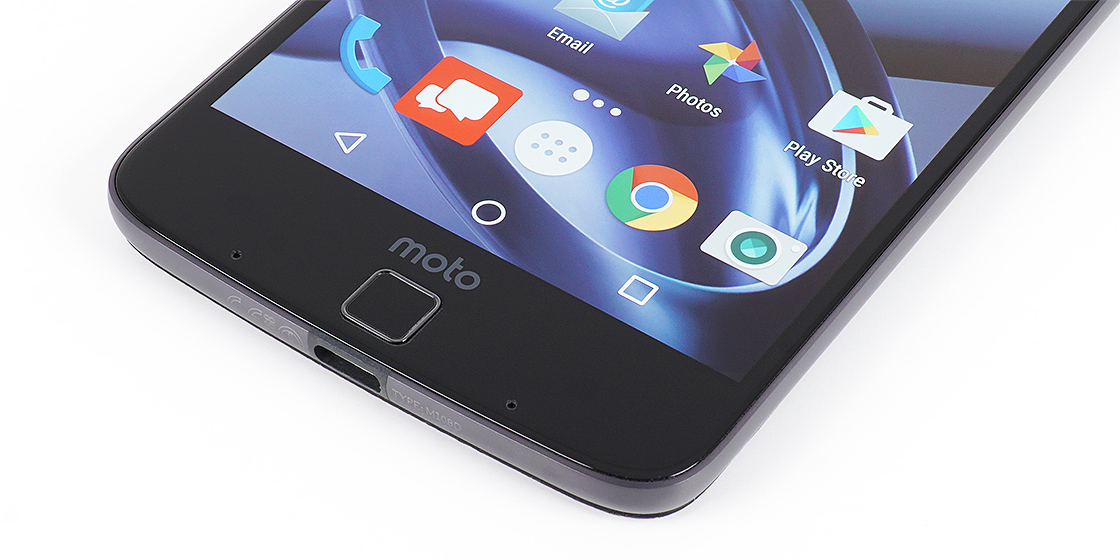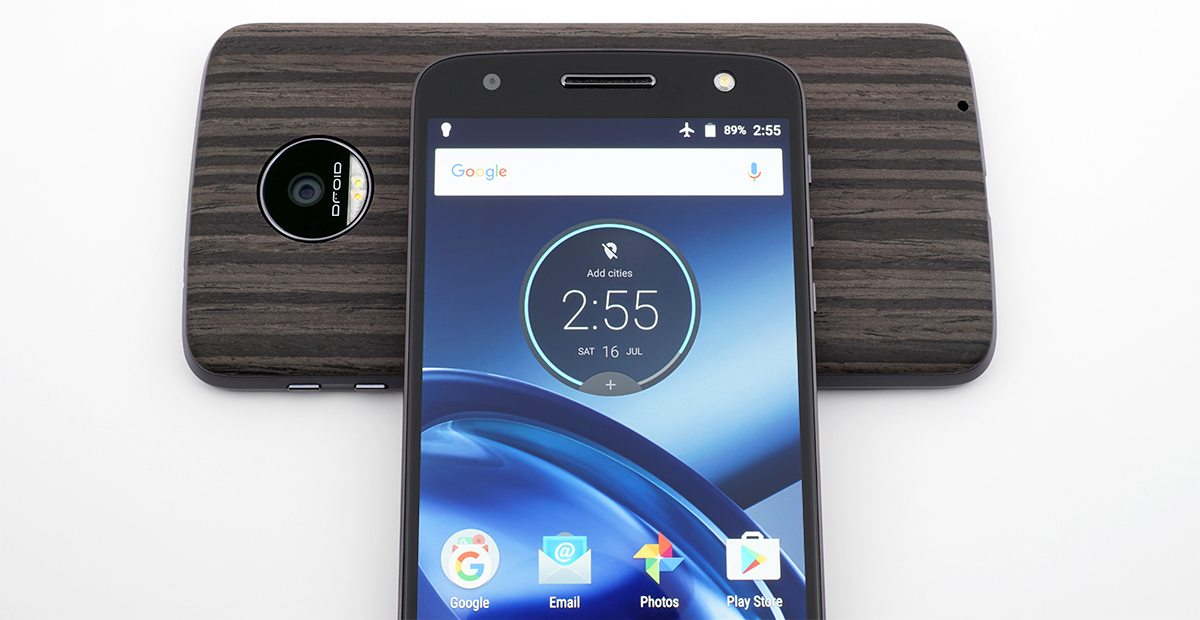The Motorola Moto Z & Moto Z Force (Droid Editions) Review
by Matt Humrick on July 28, 2016 8:00 AM EST
The relationship between Motorola and Verizon dates back to 2009 and the original Motorola Droid smartphone. Since then, the two companies have paired up for a number of Droid branded phones that are either only available from Verizon initially or are slightly tweaked models sold only by Verizon. When Motorola announced that the Moto Z and Moto Z Force will be replacing the Moto X family as the company's flagship devices at Lenovo’s Tech World event in June, it came as no surprise then that both phones would continue the Droid legacy and land exclusively on Verizon’s network first.
Unlocked versions of the Moto Z and Moto Z Force will be available directly from Motorola before the end of the year, but instead of waiting for the general release, we decided to go hands-on with Verizon’s Droid Editions, which use identical hardware.
| Motorola Moto Z Droid Family | ||
| Moto Z Droid | Moto Z Force Droid | |
| SoC | Qualcomm Snapdragon 820 (MSM8996) 2x Kryo @ 2.15GHz 2x Kryo @ 1.59GHz Adreno 530 @ 624MHz |
Qualcomm Snapdragon 820 (MSM8996) 2x Kryo @ 2.15GHz 2x Kryo @ 1.59GHz Adreno 530 @ 624MHz |
| RAM | 4GB LPDDR4-3188 | 4GB LPDDR4-3188 |
| NAND | 32GB / 64GB (UFS 2.0) + microSD |
32GB / 64GB (UFS 2.0) + microSD |
| Display | 5.5-inch 2560x1440 SAMOLED Corning Gorilla Glass |
5.5-inch 2560x1440 SAMOLED Moto ShatterShield |
| Dimensions | 153.3 x 75.3 x 5.19 mm 136 grams |
155.9 x 75.8 x 6.99 mm 163 grams |
| Modem | Qualcomm X12 (Integrated) 2G / 3G / 4G LTE (Category 12/13) |
Qualcomm X12 (Integrated) 2G / 3G / 4G LTE (Category 12/13) |
| SIM Size | NanoSIM | NanoSIM |
| Front Camera | 5MP, 1/4" OmniVision OV5693, 1.4µm pixels, f/2.2, Auto HDR, LED flash | 5MP, 1/4" OmniVision OV5693, 1.4µm pixels, f/2.2, Auto HDR, LED flash |
| Rear Camera | 13MP, 1/3.06" Sony IMX214 Exmor RS, 1.12µm pixels, f/1.8, Laser AF, OIS, Auto HDR, dual-color LED flash | 21MP, 1/2.4" Sony IMX338 Exmor RS, 1.12µm pixels, f/1.8, PDAF + Laser AF, OIS, Auto HDR, dual-color LED flash |
| Battery | 2600 mAh non-removable |
3500 mAh non-removable |
| Connectivity | 802.11a/b/g/n/ac 2x2 MIMO, BT 4.1 LE, NFC, GPS/GNSS, USB Type-C, Moto Mods connector | 802.11a/b/g/n/ac 2x2 MIMO, BT 4.1 LE, NFC, GPS/GNSS, USB Type-C, Moto Mods connector |
| Launch OS | Android 6.0.1 | Android 6.0.1 |
| Launch Price (No Contract) |
$624 ($26/mo) / $674 | $720 ($30/mo) / $770 |
Just like we’ve seen with most other flagship phones from this generation, the two Moto Z Droids come with Qualcomm's Snapdragon 820 SoC and 4GB of LPDDR4 RAM. Both models have either 32GB or 64GB of UFS 2.0 NAND, although the 64GB option is only available online through Motorola’s Moto Maker website. Internal storage can also be expanded with microSD cards. The Moto Z Droids have wireless connectivity covered with Qualcomm’s latest X12 baseband processor integrated into the SoC, Bluetooth 4.1 LE, NFC, and 802.11ac 2x2 MIMO Wi-Fi.
Unlike the Moto X phones, the Moto Z Droids come with a touch-based fingerprint sensor, a convenient security feature for unlocking the phone, authorizing purchases, and making mobile payments with Android Pay. So far I’ve found the new fingerprint sensor to be very reliable, unlocking the phone extremely quickly regardless of finger position. As with other capacitive sensors, it still has trouble with moisture and large changes in temperature, but its sensitivity to environmental factors is no worse than other solutions.
Neither of the Moto Z Droids support wireless charging, but they do include Motorola’s TurboPower fast-charging technology, which uses the included 15W or 30W chargers to provide up to 8 or 15 hours of battery life in just 15 minutes for the Moto Z Droid and Moto Z Force Droid, respectively, according to Motorola. Another shared feature is a water-repellant nano coating that protects the phones from accidental spills or light rain, but does not provide actual water or dust proofing like Samsung’s IP68 rated Galaxy S7.
While much of the internal hardware is the same, there are a few notable differences between the two models, the most significant being battery size. The Moto Z Droid comes with a 2600mAh battery, which is below the roughly 3000mAh average for phones with 5.5-inch displays. The Moto Z Force Droid bumps battery capacity to 3500mAh, which brings it close to the 3600mAh battery in Samsung’s Galaxy S7 edge. Differences in software and display efficiency will likely determine if the Force Droid can outlast the Galaxy S7 edge.
Both Moto Z Droids have the same 5MP front-facing camera with wide-angle lens that uses a dedicated LED flash and automatic HDR imaging to help capture selfies over a wider range of lighting conditions. The rear cameras both have large f/1.8 apertures and optical image stabilization to improve low-light image quality, but they use different sensors and autofocus systems. The Moto Z Droid includes a 13MP Sony sensor that pairs standard contrast-based autofocus with a laser to improve focus performance in low light. The Moto Z Force Droid uses a more advanced 21MP Sony sensor with deep trench isolation (DTI) technology for improved color fidelity. It also uses a hybrid autofocus system that combines laser, phase detection (PDAF), and contrast detection methods, which should provide faster, more reliable focusing performance in a variety of lighting conditions.
While the Moto Z Droid’s screen is covered edge to edge with Corning Gorilla Glass, the Moto Z Force Droid uses Motorola's second-generation Moto ShatterShield technology, a five-layer system that starts with an aluminum panel as a base to keep the 5.5-inch AMOLED screen from flexing. Two separate touch layers above the display provide redundancy in case one of the layers is damaged. A clear, flexible lens, likely made from a polycarbonate, is next. A second protective lens with a proprietary hardcoat completes the display stack. This assembly improves the screen's resistance to cracking or shattering if dropped, which Motorola backs by a four-year warranty.
The new Moto Z Droids’ specifications and hardware are impressive but not that much different than what’s currently available with other flagships. To make its new phones more enticing, Motorola made them modular. The idea of easily swappable accessories that extend a phone’s functionality shows promise but has not fully materialized—at least not yet. Will Motorola’s Moto Z and its modular accessories, called Moto Mods, prove useful or will they just be another wacky idea that goes nowhere?












75 Comments
View All Comments
grayson_carr - Thursday, July 28, 2016 - link
I should also say, I would have bought the regular Z and put up with a battery mod if it had the same camera as the Force. Giving the $620 standard Z, the true flagship for everyone who isn't a Verizon customer, a vastly inferior camera was a big, big mistake. I think that decision will have a direct and noticeable negative impact on sales. No one wants a $620 flagship phone with a mediocre camera in 2016, and Motorola has a great camera in the Force at their disposal! It boggles the mind. Using a different camera module in one takes more engineering resources too. Stupid, stupid, stupid.mortimerr - Thursday, July 28, 2016 - link
I would love to know what the total cost for materials is for the Moto Z. The Sony IMX214 is only used in budget devices from Chinese OEMs and devices from 2014.Cliff34 - Thursday, July 28, 2016 - link
It looks more like a marketing decision than an engineering one.kmmatney - Thursday, July 28, 2016 - link
Can you put a tempered glass cover over one of these? That should keep it from scratching.peterfares - Thursday, July 28, 2016 - link
Waiting for someone to make a keyboard mod. I'll upgrade from my PRIV immediately, the SD808 is such a terrible SoC.Manch - Friday, July 29, 2016 - link
YES!!!!! Make a keyboard attachment and Ill throw my money at them. I fucking hate touch screen kb. Took me forever to give up my original Samsung Galaxy LOL.UtilityMax - Thursday, July 28, 2016 - link
Another carrier locked flagship phone priced at +600USD, or priced at 700+ USD for the non-castrated version. Big YAWN. I don't know why I'd buy this when Nexus 5X is now on an everyday sale at about 240-250USD, and Nexus 6P, together with Oneplus 3, is 400USD.fliptwister - Thursday, July 28, 2016 - link
Very good review. I agree with most of it. I picked up the Moto Z Force today at Best Buy and I'm very impressed with the phone. The Force is thinner than I was expecting and the battery time is awesome. I have been on phone now for 4+ hours non stop and have only gone through 20% of the battery. What is really impressing me is how snappy the phone feels. My wife has the LG G5 and my buddy has the S7. I have played with these phones extensively and the Moto Z is faster. Apps open instantly. There is no hesitation in any of the phone's functions. I have not tried camera yet but I'm looking very forward to it. I get what they say in conclusion about price but the deal that Best Buy has now makes this a much better deal. I bought the Moto Z Force for $524 and I got a free JBL Soundboost Speaker (valued at $80).aryonoco - Friday, July 29, 2016 - link
Thank you for your attention to monthly security updates and dedicating a good paragraph or two to the issue.No matter how good your camera is or how well-calibrated your display is, I find it completely unacceptable for an OEM to sell a product with known and published remote root vulnerabilities.
I remember a time, pre Windows XP-SP2 when Microsoft didn't provide monthly security patches, saying similar things about the need for Enterprise testing etc. Then the tsunami of malware happened and MS and the whole PC industry recognised the need for timely security updates. Google and the mobile ecosystem is now at a similar juncture. It took Google years to finally accept the need for timely security updates, but now that they do provide monthly patches, it's up to the OEMs to follow suite.
Android OEMs need to commit to monthly security updates, and need to commit to providing such updates for a set period of time after the phone is released. Selling a phone which holds so much private information with known remote kernel-level vulnerabilities is not ok. Until such time that Android OEMs understand this, my only advice to people who care about security is: buy an iPhone, or buy a Nexus.
BrokenCrayons - Friday, July 29, 2016 - link
Yeah, how about no? Aside from the name "Moto" being utterly grating to the mind to read and even stupider sounding to utter, $600+ for a phone is really exploiting peoples' lack of self control in making decisions about what to purchase..even moreso because they're going to end up paying around $2,400 more to feed it a data connection from a cellular carrier over the course of a couple years. Fine, for a lot of us that's a drop in the bucket compared to our incomes, but I see an awful lot of lower income wage workers forking over a not-insignificant chunk of their annual income to obtain a phone from their TELCO gods.